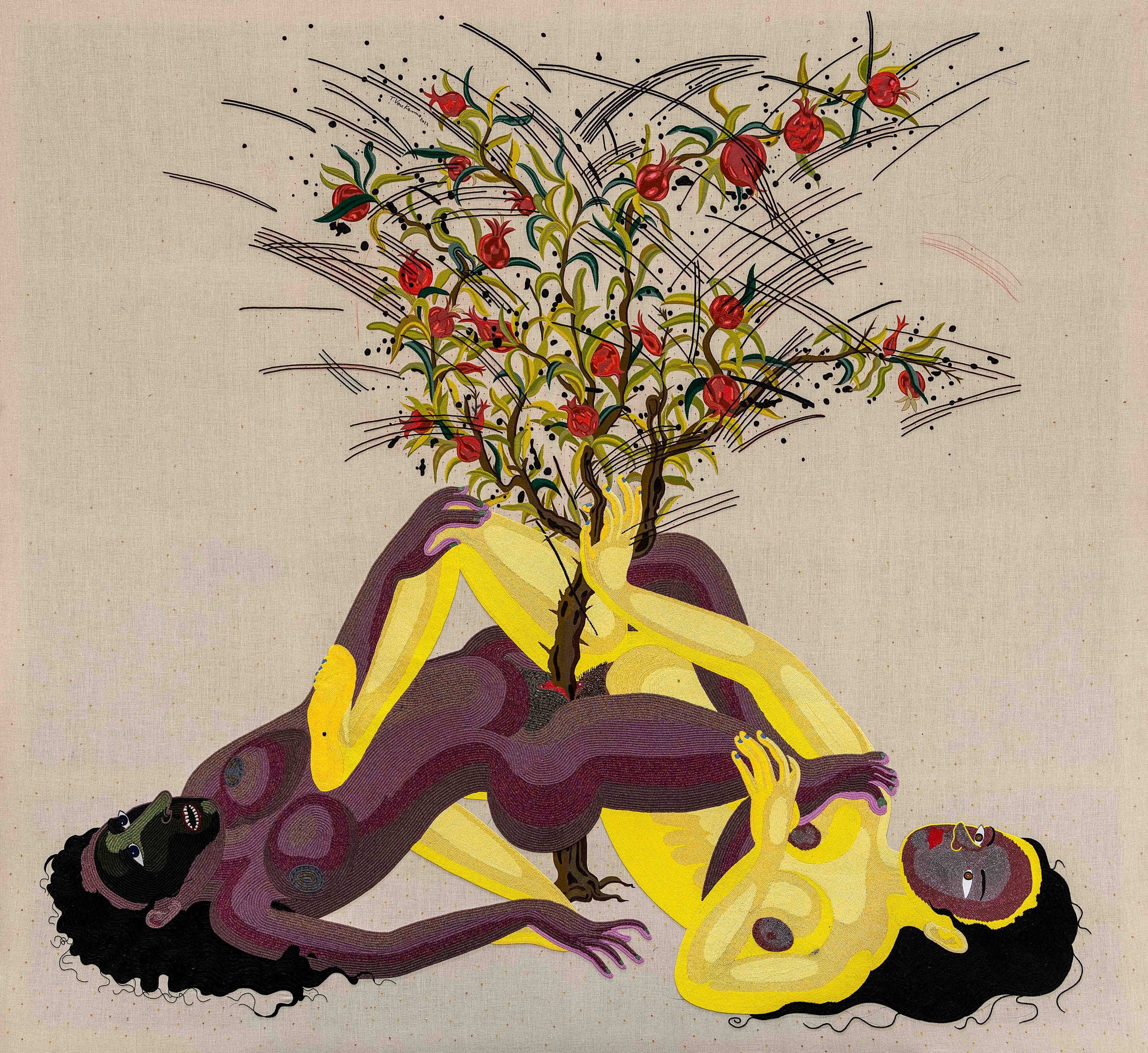T. Venkanna’s erotically charged artworks actually relay a crucial message
This article was originally published in Vogue India’s March-April 2023 issue. Cover image: ‘Same but Not the Same’, 2022, courtesy the artist and Gallery Maskara, Mumbai.
Amidst a lush, gem-toned thicket, an orgy is underway. The natural curtains of trees reveal more than they conceal. Nude figures indulge in erotic gratification. The air is thick with desire. If you close your eyes, you can almost imagine a staccato of sounds: throaty grunts of pleasure, half-suspended moans, soft sighs. T. Venkanna’s artwork, titled ‘Neither There Nor Here’ (2022), belongs to a striking collection of large-scale, hand-embroidered paintings that were exhibited at his solo show Love Me As I Am at Gallery Maskara during Mumbai Gallery Weekend in January, alongside a selection of his monochromatic watercolour drawings on Wasli paper.
The artist’s visceral creations are not meant for puritans. He presents human beings as their raw, primal selves who flout killjoy conservatism. The figures in his fantastical universe are liberated beings—free of inhibitions, moral judgment and censorship. Here, the markers of gender, caste and class cease to exist. In ‘Churning’ (2022), two women rendered in luminous threads of gold and bronze lie in an ungainly position with their hips raised high, grabbing each other by the flesh, writhing in pleasure and praying to a ripe pomegranate tree. “The tree is symbolic of fertility in many cultures,” explains Venkanna. ‘Churning’ visually elucidates same-sex couples’ desire to have children, while simultaneously serving as a powerful portrayal of gender that challenges conservative adoption laws in India.
Churning, 2022, Pencil and hand embroidery on linen. Courtesy the artist and Gallery Maskara, Mumbai.
With a practice of over 15 years, Venkanna is an artistic shape-shifter. His creative expression transcends myriad mediums, segueing effortlessly between painting, print-making, ink and watercolour drawings, sculpture, embroidery and even performance art. The artist draws strands of inspiration from post-impressionism, Mughal miniatures, early Renaissance paintings and Indian mythology, braiding them with his own imagination. Often charged with a wild and feverish energy, his artworks pirouette on the surreal.
‘Myself ’ (2023), for instance, is reminiscent of the self-sacrificing Tantric Hindu goddess Chinnamasta, who chops off her head to feed her blood to others. Viewers, however, can interpret it as the deity’s known mythological story being flipped, depicting her as a self-serving being where the severed head attends to her own needs by pleasuring her decapitated body. On a cerebral level, it’s an important lesson. “It shows how one can empower themselves,” explains the artist. “Sex as pleasure—that’s not my concern or intent.”
Myself, 2023, Pencil and hand embroidery on linen. Courtesy the artist and Gallery Maskara, Mumbai.
Meanwhile, at Gallery Maskara, the floor has transformed into an atelier. A coterie of karigars painstakingly fills yards of stretched linen with iridescent threads of emerald green, peacock blue, deep red and canary yellow. Seated on floor cushions, the artisans work in silence. Around them, tables are stacked with countless spools of coloured threads, along with jars upon jars of shimmering kardana and poth beads. The master karigars, who are creating larger-than-life ‘embroidered paintings’, have been brought to Mumbai specially from Lucknow to work with Venkanna. The collaboration between Venkanna and the karigars began in 2018, when the former was invited to an art residency at the Kalhath Institute in Lucknow which trains and celebrates Indian artisans by preserving the craft of hand-embroidery. Over the course of five years, this partnership has manifested at least 30 such paintings.
At the gallery, there is a magical synergy between the artist and the artisans. Venkanna sits beside the craftsmen and draws intricate details onto the linen with a pen. On the day we speak, he is defining the scales of a large fish clenched in the mouth of a woman. At that very moment, he decides the colours, pattern and textural treatment of the scaled vertebrate. The artisans listen and fill in the details, weaving glass beads into the fabric. The exchange is a charming jugalbandi. It’s this hybrid experience that Gallery Maskara offers its visitors, who can engage with the installed artworks while observing how the collaboration takes place in real time.
Karigars or craftsmen working on an embroidered painting at the gallery. Courtesy Gallery Maskara, Mumbai.
For the uninitiated, T. Venkanna’s ferociously beautiful artworks may seem jarring and macabre. Whether it’s an ink drawing of a monster with bulging eyes, large breasts and jagged teeth gorging on an animal (‘Untitled’, 2018) or the self-gratifying figure in ‘Myself ’, the imagery is there to shock and unsettle. It’s there to make us question our own social conditioning: why do we feel uncomfortable when we see erotica?
Astonishingly, nothing the artist draws is premeditated, reveals Abhay Maskara, the gallery’s curatorial director. “Venkanna approaches art-making from a spontaneous self. It’s very much his subconscious mind that takes the lead in the creation,” he says. “The sheer speed with which he works and the phenomenal volume of his output betrays any other possibility.”
Courtesy the artist and Gallery Maskara, Mumbai.
The artworks have an undeniable hold over the viewer. “Even when he draws,” says Maskara, emphasising the ease with which the prolific artist’s hand glides on paper, “it’s an unbroken line that ultimately forms the image. When Venkanna, who will open his next show Looking for Peace in Brussels’s Modesti Perdriolle Gallery starting April 15, approaches a blank canvas, he sits down with whatever is in front of him—whether it’s a pen, a brush, a crayon or a piece of charcoal—and everything just flows. It’s like an accomplished writer effortlessly writing prose. Artists like him come once every generation, maybe.”
Perhaps that is true. Time will tell.








